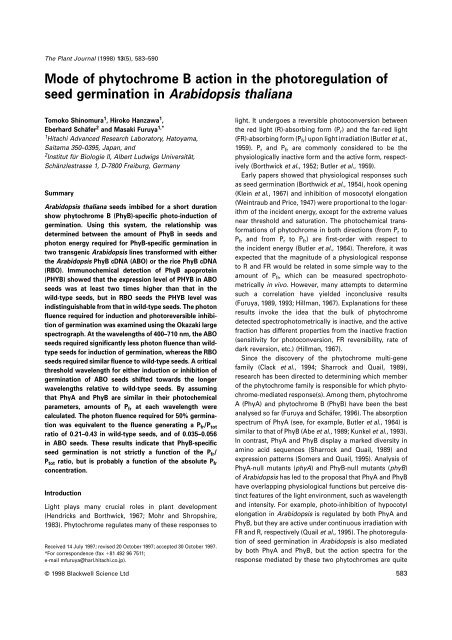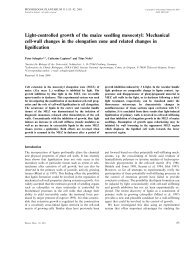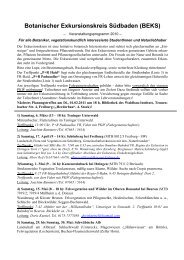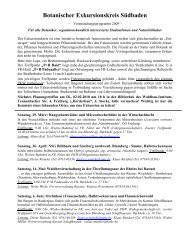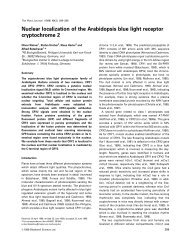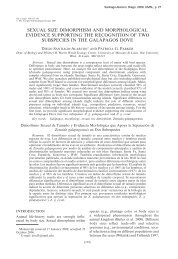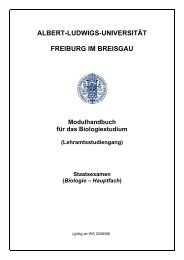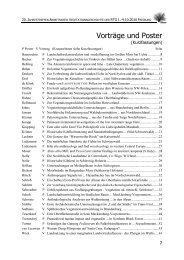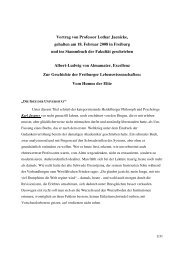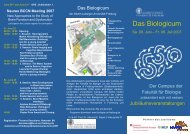Mode of phytochrome B action in the photoregulation of seed ...
Mode of phytochrome B action in the photoregulation of seed ...
Mode of phytochrome B action in the photoregulation of seed ...
Create successful ePaper yourself
Turn your PDF publications into a flip-book with our unique Google optimized e-Paper software.
The Plant Journal (1998) 13(5), 583–590<br />
<strong>Mode</strong> <strong>of</strong> <strong>phytochrome</strong> B <strong>action</strong> <strong>in</strong> <strong>the</strong> <strong>photoregulation</strong> <strong>of</strong><br />
<strong>seed</strong> germ<strong>in</strong>ation <strong>in</strong> Arabidopsis thaliana<br />
Tomoko Sh<strong>in</strong>omura1 , Hiroko Hanzawa1 ,<br />
Eberhard Schäfer2 and Masaki Furuya1,* 1Hitachi Advanced Research Laboratory, Hatoyama,<br />
Saitama 350–0395, Japan, and<br />
2Institut für Biologie II, Albert Ludwigs Universität,<br />
Schänzlestrasse 1, D-7800 Freiburg, Germany<br />
Summary<br />
Arabidopsis thaliana <strong>seed</strong>s imbibed for a short duration<br />
show <strong>phytochrome</strong> B (PhyB)-specific photo-<strong>in</strong>duction <strong>of</strong><br />
germ<strong>in</strong>ation. Us<strong>in</strong>g this system, <strong>the</strong> relationship was<br />
determ<strong>in</strong>ed between <strong>the</strong> amount <strong>of</strong> PhyB <strong>in</strong> <strong>seed</strong>s and<br />
photon energy required for PhyB-specific germ<strong>in</strong>ation <strong>in</strong><br />
two transgenic Arabidopsis l<strong>in</strong>es transformed with ei<strong>the</strong>r<br />
<strong>the</strong> Arabidopsis PhyB cDNA (ABO) or <strong>the</strong> rice PhyB cDNA<br />
(RBO). Immunochemical detection <strong>of</strong> PhyB apoprote<strong>in</strong><br />
(PHYB) showed that <strong>the</strong> expression level <strong>of</strong> PHYB <strong>in</strong> ABO<br />
<strong>seed</strong>s was at least two times higher than that <strong>in</strong> <strong>the</strong><br />
wild-type <strong>seed</strong>s, but <strong>in</strong> RBO <strong>seed</strong>s <strong>the</strong> PHYB level was<br />
<strong>in</strong>dist<strong>in</strong>guishable from that <strong>in</strong> wild-type <strong>seed</strong>s. The photon<br />
fluence required for <strong>in</strong>duction and photoreversible <strong>in</strong>hibition<br />
<strong>of</strong> germ<strong>in</strong>ation was exam<strong>in</strong>ed us<strong>in</strong>g <strong>the</strong> Okazaki large<br />
spectrograph. At <strong>the</strong> wavelengths <strong>of</strong> 400–710 nm, <strong>the</strong> ABO<br />
<strong>seed</strong>s required significantly less photon fluence than wildtype<br />
<strong>seed</strong>s for <strong>in</strong>duction <strong>of</strong> germ<strong>in</strong>ation, whereas <strong>the</strong> RBO<br />
<strong>seed</strong>s required similar fluence to wild-type <strong>seed</strong>s. A critical<br />
threshold wavelength for ei<strong>the</strong>r <strong>in</strong>duction or <strong>in</strong>hibition <strong>of</strong><br />
germ<strong>in</strong>ation <strong>of</strong> ABO <strong>seed</strong>s shifted towards <strong>the</strong> longer<br />
wavelengths relative to wild-type <strong>seed</strong>s. By assum<strong>in</strong>g<br />
that PhyA and PhyB are similar <strong>in</strong> <strong>the</strong>ir photochemical<br />
parameters, amounts <strong>of</strong> P fr at each wavelength were<br />
calculated. The photon fluence required for 50% germ<strong>in</strong>ation<br />
was equivalent to <strong>the</strong> fluence generat<strong>in</strong>g a P fr/P tot<br />
ratio <strong>of</strong> 0.21–0.43 <strong>in</strong> wild-type <strong>seed</strong>s, and <strong>of</strong> 0.035–0.056<br />
<strong>in</strong> ABO <strong>seed</strong>s. These results <strong>in</strong>dicate that PhyB-specific<br />
<strong>seed</strong> germ<strong>in</strong>ation is not strictly a function <strong>of</strong> <strong>the</strong> P fr/<br />
P tot ratio, but is probably a function <strong>of</strong> <strong>the</strong> absolute P fr<br />
concentration.<br />
Introduction<br />
Light plays many crucial roles <strong>in</strong> plant development<br />
(Hendricks and Borthwick, 1967; Mohr and Shropshire,<br />
1983). Phytochrome regulates many <strong>of</strong> <strong>the</strong>se responses to<br />
Received 14 July 1997; revised 20 October 1997; accepted 30 October 1997.<br />
*For correspondence (fax �81 492 96 7511;<br />
e-mail mfuruya@harl.hitachi.co.jp).<br />
light. It undergoes a reversible photoconversion between<br />
<strong>the</strong> red light (R)-absorb<strong>in</strong>g form (P r) and <strong>the</strong> far-red light<br />
(FR)-absorb<strong>in</strong>g form (P fr) upon light irradiation (Butler et al.,<br />
1959). P r and P fr are commonly considered to be <strong>the</strong><br />
physiologically <strong>in</strong>active form and <strong>the</strong> active form, respectively<br />
(Borthwick et al., 1952; Butler et al., 1959).<br />
Early papers showed that physiological responses such<br />
as <strong>seed</strong> germ<strong>in</strong>ation (Borthwick et al., 1954), hook open<strong>in</strong>g<br />
(Kle<strong>in</strong> et al., 1967) and <strong>in</strong>hibition <strong>of</strong> mosocotyl elongation<br />
(We<strong>in</strong>traub and Price, 1947) were proportional to <strong>the</strong> logarithm<br />
<strong>of</strong> <strong>the</strong> <strong>in</strong>cident energy, except for <strong>the</strong> extreme values<br />
near threshold and saturation. The photochemical transformations<br />
<strong>of</strong> <strong>phytochrome</strong> <strong>in</strong> both directions (from P r to<br />
P fr and from P r to P fr) are first-order with respect to<br />
<strong>the</strong> <strong>in</strong>cident energy (Butler et al., 1964). Therefore, it was<br />
expected that <strong>the</strong> magnitude <strong>of</strong> a physiological response<br />
to R and FR would be related <strong>in</strong> some simple way to <strong>the</strong><br />
amount <strong>of</strong> P fr, which can be measured spectrophotometrically<br />
<strong>in</strong> vivo. However, many attempts to determ<strong>in</strong>e<br />
such a correlation have yielded <strong>in</strong>conclusive results<br />
(Furuya, 1989, 1993; Hillman, 1967). Explanations for <strong>the</strong>se<br />
results <strong>in</strong>voke <strong>the</strong> idea that <strong>the</strong> bulk <strong>of</strong> <strong>phytochrome</strong><br />
detected spectrophotometrically is <strong>in</strong>active, and <strong>the</strong> active<br />
fr<strong>action</strong> has different properties from <strong>the</strong> <strong>in</strong>active fr<strong>action</strong><br />
(sensitivity for photoconversion, FR reversibility, rate <strong>of</strong><br />
dark reversion, etc.) (Hillman, 1967).<br />
S<strong>in</strong>ce <strong>the</strong> discovery <strong>of</strong> <strong>the</strong> <strong>phytochrome</strong> multi-gene<br />
family (Clack et al., 1994; Sharrock and Quail, 1989),<br />
research has been directed to determ<strong>in</strong><strong>in</strong>g which member<br />
<strong>of</strong> <strong>the</strong> <strong>phytochrome</strong> family is responsible for which <strong>phytochrome</strong>-mediated<br />
response(s). Among <strong>the</strong>m, <strong>phytochrome</strong><br />
A (PhyA) and <strong>phytochrome</strong> B (PhyB) have been <strong>the</strong> best<br />
analysed so far (Furuya and Schäfer, 1996). The absorption<br />
spectrum <strong>of</strong> PhyA (see, for example, Butler et al., 1964) is<br />
similar to that <strong>of</strong> PhyB (Abe et al., 1989; Kunkel et al., 1993).<br />
In contrast, PhyA and PhyB display a marked diversity <strong>in</strong><br />
am<strong>in</strong>o acid sequences (Sharrock and Quail, 1989) and<br />
expression patterns (Somers and Quail, 1995). Analysis <strong>of</strong><br />
PhyA-null mutants (phyA) and PhyB-null mutants (phyB)<br />
<strong>of</strong> Arabidopsis has led to <strong>the</strong> proposal that PhyA and PhyB<br />
have overlapp<strong>in</strong>g physiological functions but perceive dist<strong>in</strong>ct<br />
features <strong>of</strong> <strong>the</strong> light environment, such as wavelength<br />
and <strong>in</strong>tensity. For example, photo-<strong>in</strong>hibition <strong>of</strong> hypocotyl<br />
elongation <strong>in</strong> Arabidopsis is regulated by both PhyA and<br />
PhyB, but <strong>the</strong>y are active under cont<strong>in</strong>uous irradiation with<br />
FR and R, respectively (Quail et al., 1995). The <strong>photoregulation</strong><br />
<strong>of</strong> <strong>seed</strong> germ<strong>in</strong>ation <strong>in</strong> Arabidopsis is also mediated<br />
by both PhyA and PhyB, but <strong>the</strong> <strong>action</strong> spectra for <strong>the</strong><br />
response mediated by <strong>the</strong>se two <strong>phytochrome</strong>s are quite<br />
© 1998 Blackwell Science Ltd 583
584 Tomoko Sh<strong>in</strong>omura et al.<br />
different <strong>in</strong> <strong>the</strong>ir photon fluence and wavelength requirements<br />
(Sh<strong>in</strong>omura et al., 1996).<br />
These data suggest that one <strong>of</strong> <strong>the</strong> explanations for <strong>the</strong><br />
previous <strong>in</strong>ability to correlate physiological responses with<br />
<strong>the</strong> amount <strong>of</strong> P fr was due to <strong>the</strong> simultaneous spectrophotometric<br />
measurement <strong>of</strong> multiple <strong>phytochrome</strong>s with<br />
differential responses. In order to address this question,<br />
we concentrated on PhyB-specific <strong>seed</strong> germ<strong>in</strong>ation us<strong>in</strong>g<br />
PhyB over-express<strong>in</strong>g transgenic plants. The PhyB role <strong>in</strong><br />
<strong>seed</strong> germ<strong>in</strong>ation is dist<strong>in</strong>guishable from that <strong>of</strong> <strong>the</strong> o<strong>the</strong>r<br />
<strong>phytochrome</strong>s when <strong>seed</strong>s are allowed to imbibe water<br />
for a short period before <strong>the</strong> light treatment (Sh<strong>in</strong>omura<br />
et al., 1994, 1996). The over-expression level <strong>of</strong> <strong>phytochrome</strong>(s)<br />
<strong>in</strong> <strong>seed</strong> has not been demonstrated <strong>in</strong> transgenics<br />
<strong>of</strong> <strong>phytochrome</strong> genes, although <strong>the</strong> expression<br />
level <strong>in</strong> <strong>seed</strong>l<strong>in</strong>gs were measured both immunochemically<br />
and spectrophotometrically (Wagner et al., 1991).<br />
We describe here light fluence–response relationships<br />
<strong>in</strong> PhyB over-express<strong>in</strong>g transgenics that showed different<br />
PhyB levels <strong>in</strong> <strong>seed</strong>s. Quantitative correlation between<br />
<strong>the</strong> amount <strong>of</strong> PhyB <strong>in</strong> P fr form <strong>in</strong> <strong>seed</strong>s and <strong>the</strong> light<br />
energy required for PhyB-<strong>in</strong>duced germ<strong>in</strong>ation will be<br />
discussed.<br />
Results<br />
Immunochemical determ<strong>in</strong>ation <strong>of</strong> PHYB amount <strong>in</strong><br />
<strong>seed</strong>s <strong>of</strong> RBO and ABO<br />
The amount <strong>of</strong> PhyB apoprote<strong>in</strong> (PHYB) <strong>in</strong> <strong>seed</strong>s was<br />
quantified by immunoblot analysis <strong>of</strong> crude <strong>seed</strong> extracts<br />
from two homozygous transgenic l<strong>in</strong>es, transformed with<br />
ei<strong>the</strong>r <strong>the</strong> cDNA <strong>of</strong> <strong>the</strong> Arabidopsis PhyB gene (ABO) or<br />
<strong>the</strong> cDNA <strong>of</strong> <strong>the</strong> rice PhyB gene (RBO). Us<strong>in</strong>g a monoclonal<br />
antibody which reacts with Arabidopsis PHYB, it was demonstrated<br />
that <strong>the</strong> total amount <strong>of</strong> PHYB <strong>in</strong> ABO <strong>seed</strong>s was<br />
greater than that <strong>in</strong> <strong>the</strong> wild-type (WT) <strong>seed</strong>s (Figure 1b).<br />
The magnitude <strong>of</strong> <strong>the</strong> difference <strong>in</strong> PhyB expression levels<br />
between ABO and WT <strong>seed</strong>s was smaller than that <strong>in</strong><br />
<strong>seed</strong>l<strong>in</strong>gs (Figure 1b). Based on a serial dilution comparison<br />
<strong>of</strong> <strong>the</strong> extracts derived from ABO and WT, we estimated<br />
that ABO <strong>seed</strong>s showed more than twice <strong>the</strong> level <strong>of</strong> PHYB<br />
than WT <strong>seed</strong>s (Figure 1c). However, us<strong>in</strong>g <strong>the</strong> monoclonal<br />
antibody which reacts with both rice PHYB and Arabidopsis<br />
PHYB, <strong>the</strong> amount <strong>of</strong> PHYB <strong>in</strong> RBO <strong>seed</strong>s was <strong>in</strong>dist<strong>in</strong>guishable<br />
from <strong>the</strong> levels observed <strong>in</strong> WT <strong>seed</strong>s (Figure 1a).<br />
In contrast, <strong>the</strong> amount <strong>of</strong> PHYB <strong>in</strong> RBO <strong>seed</strong>l<strong>in</strong>gs was<br />
substantially higher than that <strong>in</strong> WT <strong>seed</strong>l<strong>in</strong>gs (Figure 1a).<br />
In conclusion, both ABO and RBO <strong>seed</strong>s showed lower<br />
expression levels <strong>of</strong> PHYB than <strong>seed</strong>l<strong>in</strong>gs, and only ABO<br />
<strong>seed</strong>s exhibited substantial over-expression <strong>of</strong> PHYB <strong>in</strong><br />
<strong>seed</strong>s.<br />
Figure 1. Immunochemical detection <strong>of</strong> Arabidopsis PHYB and rice PHYB<br />
apoprote<strong>in</strong>s extracted from <strong>seed</strong>s and <strong>seed</strong>l<strong>in</strong>gs <strong>of</strong> RBO and ABO.<br />
(a) Crude prote<strong>in</strong> extracts from <strong>seed</strong>s and <strong>seed</strong>l<strong>in</strong>gs <strong>of</strong> WT and RBO were<br />
loaded (50 μg prote<strong>in</strong> <strong>in</strong> each lane) and probed with mBT4 which reacts<br />
with both rice PHYB and Arabidopsis PHYB.<br />
(b) Crude prote<strong>in</strong> extracts <strong>of</strong> WT and ABO were loaded (40 μg prote<strong>in</strong> <strong>in</strong><br />
each lane) and probed with mBA2 which reacts with Arabidopsis PHYB.<br />
(c) Crude extract from ABO <strong>seed</strong>s conta<strong>in</strong><strong>in</strong>g 40 μg prote<strong>in</strong> was serially<br />
diluted to half <strong>of</strong> <strong>the</strong> concentration with extr<strong>action</strong> buffer and probed<br />
with mBA2.<br />
Figure 2. Effect <strong>of</strong> photon fluence <strong>of</strong> 667 nm light on <strong>in</strong>duction <strong>of</strong> PhyBdependent<br />
<strong>seed</strong> germ<strong>in</strong>ation.<br />
The experiment was performed on <strong>seed</strong>s <strong>of</strong> WT (s), <strong>the</strong> phyB mutant (r),<br />
RBO (n) and ABO (u).<br />
Photon fluence <strong>of</strong> R required for <strong>seed</strong> germ<strong>in</strong>ation <strong>in</strong><br />
ABO<br />
Experiments were designed to determ<strong>in</strong>e <strong>the</strong> photon<br />
fluence requirement <strong>of</strong> 667 nm light for PhyB-specific<br />
germ<strong>in</strong>ation. WT (ecotype Nossen) <strong>seed</strong>s effectively<br />
germ<strong>in</strong>ated when irradiated with a fluence higher than<br />
20 μmol m –2 <strong>of</strong> 667 nm light and reached a maximum at a<br />
fluence <strong>of</strong> 200 μmol m –2 (Figure 2). This range <strong>of</strong> photon<br />
fluence is equivalent to <strong>the</strong> PhyB-specific germ<strong>in</strong>ation<br />
previously reported <strong>in</strong> A. thaliana ecotype Landsberg erecta<br />
(Sh<strong>in</strong>omura et al., 1996). Moreover, <strong>seed</strong>s <strong>of</strong> <strong>the</strong> phyB<br />
© Blackwell Science Ltd, The Plant Journal, (1998), 13, 583–590
mutant (established by cross<strong>in</strong>g with Nossen) did not show<br />
photo-<strong>in</strong>duction <strong>of</strong> germ<strong>in</strong>ation when <strong>the</strong>y were allowed<br />
to imbibe water for 3 h (Figure 2), aga<strong>in</strong> similar to <strong>the</strong> phyB<br />
mutant <strong>of</strong> Landsberg erecta (Sh<strong>in</strong>omura et al., 1994).<br />
To determ<strong>in</strong>e whe<strong>the</strong>r an <strong>in</strong>crease <strong>of</strong> over-expressed<br />
PhyB causes an <strong>in</strong>crease or decrease <strong>in</strong> <strong>the</strong> photon fluence<br />
required for <strong>in</strong>duction <strong>of</strong> PhyB-specific germ<strong>in</strong>ation, we<br />
exam<strong>in</strong>ed <strong>the</strong> effect <strong>of</strong> various ranges <strong>of</strong> photon fluence<br />
<strong>of</strong> R (667 nm) on <strong>the</strong> photo-<strong>in</strong>duction <strong>of</strong> RBO and ABO <strong>seed</strong><br />
germ<strong>in</strong>ation. The RBO <strong>seed</strong>s showed similar sensitivity to<br />
that <strong>of</strong> WT <strong>seed</strong>s (Figure 2). In contrast, ABO <strong>seed</strong>s showed<br />
more sensitive <strong>in</strong>duction <strong>of</strong> germ<strong>in</strong>ation than that <strong>of</strong> WT;<br />
photo-<strong>in</strong>duction occurred by irradiation with a fluence<br />
higher than 7 μmol m –2 <strong>of</strong> 667 nm light and reached a<br />
maximum at a fluence <strong>of</strong> 70 μmol m –2 (Figure 2).<br />
The present results (Figure 2) toge<strong>the</strong>r with data on<br />
immunochemical detection <strong>of</strong> PHYB <strong>in</strong> <strong>seed</strong>s <strong>of</strong> RBO and<br />
ABO (Figure 1) <strong>in</strong>dicate that <strong>the</strong> higher <strong>the</strong> amount <strong>of</strong> PHYB<br />
<strong>in</strong> <strong>seed</strong>s, <strong>the</strong> less photon fluence <strong>of</strong> R required for <strong>the</strong><br />
PhyB-specific photo-<strong>in</strong>duction <strong>of</strong> <strong>seed</strong> germ<strong>in</strong>ation.<br />
Shift <strong>of</strong> effective range <strong>of</strong> wavelength <strong>in</strong> ABO<br />
In order to assess whe<strong>the</strong>r <strong>the</strong> over-expression <strong>of</strong> PHYB<br />
leads to a shift <strong>in</strong> <strong>the</strong> effective range <strong>of</strong> wavelength for<br />
<strong>in</strong>duction <strong>of</strong> germ<strong>in</strong>ation, we exam<strong>in</strong>ed <strong>the</strong> effect <strong>of</strong> various<br />
photon fluences <strong>of</strong> monochromatic light <strong>in</strong> <strong>the</strong> spectral<br />
range from 300–720 nm on germ<strong>in</strong>ation us<strong>in</strong>g <strong>the</strong> Okazaki<br />
large spectrograph. RBO showed similar sensitivity to WT<br />
at all wavelengths exam<strong>in</strong>ed (data not shown). Representative<br />
fluence–response curves for <strong>in</strong>duction <strong>of</strong> germ<strong>in</strong>ation<br />
<strong>in</strong> WT and ABO are presented <strong>in</strong> Figure 3.<br />
Based on <strong>the</strong> similarity and differences between <strong>the</strong><br />
fluence–response curves <strong>of</strong> WT and <strong>of</strong> ABO, <strong>the</strong> range <strong>of</strong><br />
wavelength was divided <strong>in</strong>to three groups. In <strong>the</strong> wavelength<br />
range 300–350 nm, both WT and ABO showed<br />
similar fluence–response curves (Figure 3). In <strong>the</strong> range<br />
400–690 nm, both reached a maximum <strong>of</strong> 100% germ<strong>in</strong>ation,<br />
but <strong>the</strong> ABO <strong>seed</strong>s germ<strong>in</strong>ated with a lower photon<br />
fluence than WT <strong>seed</strong>s (Figure 3). Wavelengths longer than<br />
690 nm showed complicated fluence–response curves.<br />
From 694 nm, <strong>the</strong> f<strong>in</strong>al germ<strong>in</strong>ation percentages <strong>of</strong> WT<br />
<strong>seed</strong>s decreased, and irradiation with monochromatic light<br />
longer than 700 nm did not <strong>in</strong>duce germ<strong>in</strong>ation with<strong>in</strong><br />
<strong>the</strong> fluence range exam<strong>in</strong>ed (less than 100 mmol m –2 )<br />
(Figure 3). In contrast, ABO <strong>seed</strong>s germ<strong>in</strong>ated to 100% by<br />
irradiation with monochromatic light from 694–700 nm<br />
(Figure 3). From 705–715 nm, <strong>the</strong> f<strong>in</strong>al germ<strong>in</strong>ation percentages<br />
<strong>of</strong> ABO <strong>seed</strong>s decreased (Figure 3), and irradiation<br />
with monochromatic light longer than 720 nm did not<br />
<strong>in</strong>duce germ<strong>in</strong>ation with<strong>in</strong> <strong>the</strong> fluence range exam<strong>in</strong>ed<br />
(less than 100 mmol m –2 , data not shown). Thus, <strong>in</strong> WT<br />
<strong>seed</strong>s, a critical threshold <strong>of</strong> response to light wavelength<br />
occurred between 700 and 705 nm. In contrast, <strong>the</strong> corres-<br />
© Blackwell Science Ltd, The Plant Journal, (1998), 13, 583–590<br />
<strong>Mode</strong> <strong>of</strong> <strong>phytochrome</strong> B <strong>action</strong> <strong>in</strong> <strong>seed</strong> germ<strong>in</strong>ation 585<br />
Figure 3. Effect <strong>of</strong> photon fluence <strong>of</strong> 300–715 nm light on <strong>in</strong>duction <strong>of</strong> PhyBdependent<br />
<strong>seed</strong> germ<strong>in</strong>ation.<br />
Representative fluence-response relationships for WT (s) and ABO (u)<br />
<strong>seed</strong>s are shown. Wavelengths are shown <strong>in</strong> each section.<br />
pond<strong>in</strong>g critical wavelength for ABO shifted <strong>in</strong> <strong>the</strong> direction<br />
<strong>of</strong> longer wavelength. An explanation for <strong>the</strong>se phenomena<br />
may relate to <strong>the</strong> photoconversion <strong>of</strong> <strong>phytochrome</strong> at<br />
photostationary state (see Discussion).<br />
Photoreversible <strong>in</strong>hibition <strong>of</strong> germ<strong>in</strong>ation <strong>in</strong> ABO<br />
To determ<strong>in</strong>e whe<strong>the</strong>r <strong>the</strong> over-expressed PHYB has any<br />
physiological effects on PhyB-specific photoreversible<br />
regulation <strong>in</strong> <strong>seed</strong>s, we exam<strong>in</strong>ed R/FR reversibility <strong>of</strong> <strong>seed</strong><br />
germ<strong>in</strong>ation <strong>in</strong> WT, ABO and RBO. All <strong>of</strong> <strong>the</strong> l<strong>in</strong>es clearly<br />
exhibited R/FR reversibility by irradiation with R<br />
(5.8 mmol m –2 ) and <strong>the</strong>n FR (18 mmol m –2 ) (data not<br />
shown). This result establishes that over-expressed PHYB<br />
does not <strong>in</strong>terfere with <strong>the</strong> R/FR reversible regulation <strong>of</strong><br />
<strong>seed</strong> germ<strong>in</strong>ation with<strong>in</strong> <strong>the</strong> photon fluence range<br />
exam<strong>in</strong>ed.
586 Tomoko Sh<strong>in</strong>omura et al.<br />
Figure 4. Effect <strong>of</strong> photon fluence <strong>of</strong> 690–820 nm on photoreversible<br />
<strong>in</strong>hibition <strong>of</strong> PhyB-dependent germ<strong>in</strong>ation.<br />
WT (s) and ABO (u) <strong>seed</strong>s were exposed to saturat<strong>in</strong>g R and subsequently<br />
irradiated with monochromatic light. Representative fluence–response<br />
relationships are shown.<br />
To assess whe<strong>the</strong>r PHYB over-express<strong>in</strong>g <strong>seed</strong>s are different<br />
from WT <strong>seed</strong>s <strong>in</strong> terms <strong>of</strong> <strong>the</strong>ir requirements for<br />
light quantity or wavelength for photoreversible <strong>in</strong>hibition<br />
<strong>of</strong> germ<strong>in</strong>ation, fluence–response curves at 690–820 nm<br />
were determ<strong>in</strong>ed (Figure 4). In <strong>the</strong> spectral range <strong>of</strong> 715–<br />
820 nm, ABO required a higher photon fluence level than<br />
WT to reverse <strong>the</strong> promotion <strong>of</strong> <strong>seed</strong> germ<strong>in</strong>ation <strong>in</strong>duced<br />
by previous irradiation with R (1.5 mmol m –2 ); for example,<br />
ABO <strong>seed</strong>s required more than 12 times greater fluence <strong>of</strong><br />
750 nm than WT <strong>seed</strong>s (Figure 4). The photoreversible<br />
<strong>in</strong>hibition <strong>of</strong> germ<strong>in</strong>ation by FR <strong>the</strong>refore required higher<br />
fluences <strong>in</strong> <strong>the</strong> case <strong>of</strong> ABO than WT, which is opposite to<br />
<strong>the</strong> case for <strong>the</strong> <strong>in</strong>duction <strong>of</strong> germ<strong>in</strong>ation by R.<br />
The effective range <strong>of</strong> light wavelengths for photoreversible<br />
<strong>in</strong>hibition <strong>of</strong> germ<strong>in</strong>ation was exam<strong>in</strong>ed. Reversibility<br />
was observed <strong>in</strong> <strong>the</strong> range <strong>of</strong> 690–820 nm for WT <strong>seed</strong>s<br />
(Figure 4). In contrast, <strong>in</strong> ABO <strong>seed</strong>s, reversibility was not<br />
observed at wavelengths shorter than 710 nm, but was<br />
observed at wavelengths longer than 715 nm (Figure 4).<br />
Thus, a critical threshold <strong>of</strong> light wavelength required for<br />
photoreversible <strong>in</strong>hibition <strong>of</strong> WT <strong>seed</strong> germ<strong>in</strong>ation was<br />
postulated between 690 and 698 nm. In contrast, <strong>the</strong> correspond<strong>in</strong>g<br />
wavelength for ABO <strong>seed</strong>s shifted to <strong>the</strong> direction<br />
<strong>of</strong> longer wavelengths between 710 nm and 715 nm. These<br />
results correlated well with <strong>the</strong> shift <strong>of</strong> <strong>the</strong> critical wavelength<br />
observed <strong>in</strong> <strong>the</strong> <strong>in</strong>duction <strong>of</strong> germ<strong>in</strong>ation (Figure 3).<br />
Discussion<br />
The present study demonstrated that <strong>the</strong> expression level<br />
<strong>of</strong> PHYB <strong>in</strong> both ABO and RBO was substantially lower <strong>in</strong><br />
<strong>seed</strong>s than <strong>in</strong> <strong>seed</strong>l<strong>in</strong>gs (Figure 1). In previous papers, <strong>the</strong><br />
PHYB expression levels <strong>in</strong> <strong>phytochrome</strong> over-express<strong>in</strong>g<br />
transgenic plants were determ<strong>in</strong>ed <strong>in</strong> <strong>the</strong> <strong>seed</strong>l<strong>in</strong>g stage<br />
<strong>of</strong> development (Boylan and Quail, 1989, 1991; Cherry<br />
et al., 1991; Kay et al., 1989; Wagner et al., 1991). In contrast,<br />
relatively little evidence has been provided for <strong>the</strong> amount<br />
<strong>of</strong> <strong>phytochrome</strong> <strong>in</strong> <strong>seed</strong>s, ei<strong>the</strong>r us<strong>in</strong>g spectrophotometric<br />
techniques (see reviews, Frankland and Taylorson, 1983;<br />
Sh<strong>in</strong>omura, 1997) or immunochemical techniques (Konomi<br />
et al., 1985, 1987). These results showed that <strong>the</strong> total<br />
amount <strong>of</strong> <strong>phytochrome</strong> <strong>in</strong> <strong>seed</strong>s is very low. Because<br />
PHYB levels <strong>in</strong> Arabidopsis are spectrophotometrically<br />
undetectable <strong>in</strong> WT <strong>seed</strong>l<strong>in</strong>gs (Wagner et al., 1991) and <strong>in</strong><br />
WT <strong>seed</strong>s (Hanzawa et al., unpublished data), only immunochemical<br />
techniques have been successful <strong>in</strong> determ<strong>in</strong><strong>in</strong>g<br />
<strong>the</strong> level <strong>of</strong> PHYB (Sh<strong>in</strong>omura et al., 1994, 1996). The<br />
differences <strong>in</strong> <strong>the</strong> PHYB expression level observed between<br />
<strong>seed</strong>s and <strong>seed</strong>l<strong>in</strong>gs (Figure 1) may be due to <strong>the</strong> differential<br />
activation <strong>of</strong> <strong>the</strong> cauliflower mosaic virus 35S promoter<br />
or <strong>the</strong> differential stability <strong>of</strong> PHYB between <strong>the</strong>se two<br />
developmental stages.<br />
Transgenic Arabidopsis l<strong>in</strong>es over-express<strong>in</strong>g PhyB are<br />
powerful tools to <strong>in</strong>vestigate <strong>the</strong> role <strong>of</strong> PhyB as <strong>the</strong>y allow<br />
<strong>the</strong> effects <strong>of</strong> changes to be studied <strong>in</strong> <strong>the</strong> absolute amount<br />
<strong>of</strong> PhyB <strong>in</strong> vivo (Wagner et al., 1991). The present study<br />
showed that over-expressed PhyB <strong>in</strong> ABO <strong>seed</strong>s functions<br />
<strong>in</strong> a similar way to <strong>the</strong> endogenous PhyB <strong>in</strong> terms <strong>of</strong> <strong>the</strong> R/<br />
FR-reversible regulation <strong>of</strong> germ<strong>in</strong>ation by brief irradiation<br />
(Figure 4). This observation is consistent with <strong>the</strong> results<br />
demonstrat<strong>in</strong>g R/FR reversibility obta<strong>in</strong>ed from <strong>the</strong> test <strong>of</strong><br />
<strong>in</strong>hibition <strong>of</strong> hypocotyl elongation growth <strong>in</strong> ABO and RBO<br />
by <strong>in</strong>termittent irradiation with R and/or FR (McCormac<br />
et al., 1993b).<br />
The present study demonstrated, for <strong>the</strong> first time, <strong>the</strong><br />
quantitative relationship between PhyB and its effect on<br />
<strong>seed</strong> germ<strong>in</strong>ation. Previous work has <strong>in</strong>vestigated <strong>the</strong><br />
photon fluence <strong>of</strong> R and FR required for <strong>seed</strong> germ<strong>in</strong>ation <strong>of</strong><br />
transgenic tobacco over-express<strong>in</strong>g oat PHYA (McCormac<br />
et al., 1993a), but that work was carried out without <strong>the</strong><br />
knowledge <strong>of</strong> <strong>the</strong> differential roles <strong>of</strong> endogenous PhyA<br />
and PhyB for <strong>seed</strong> germ<strong>in</strong>ation. In contrast, <strong>the</strong> present<br />
study demonstrated that <strong>the</strong> <strong>seed</strong>s express<strong>in</strong>g twice <strong>the</strong><br />
total amount <strong>of</strong> PHYB relative to WT (Figure 1) required<br />
© Blackwell Science Ltd, The Plant Journal, (1998), 13, 583–590
<strong>Mode</strong> <strong>of</strong> <strong>phytochrome</strong> B <strong>action</strong> <strong>in</strong> <strong>seed</strong> germ<strong>in</strong>ation 587<br />
Table 1. Photon fluence required for <strong>in</strong>duction <strong>of</strong> 50% germ<strong>in</strong>ation <strong>in</strong> <strong>the</strong> wild-type and ABO <strong>seed</strong>s, and calculated P fr/P tot ratio<br />
Wavelength T a P fr/P r ratio at photo- WT (No-0) ABO<br />
(nm) equilibrium<br />
RF a Calculated P fr/P r RF a Calculated P fr/P r<br />
(μmol m –2 ) ratio (μmol m –2 ) ratio<br />
300 0.11 0.66 c 1100 0.60 660 0.50<br />
350 0.063 0.75 c 1600 0.66 460 0.34<br />
400 0.14 0.57 c 4200 0.57 130 0.10<br />
480 0.37 0.45 c 18 000 0.43 670 0.048<br />
505 0.42 0.51 c 11 000 0.40 840 0.056<br />
530 0.46 0.68 c 2300 0.25 320 0.042<br />
550 0.49 0.80 c 1800 0.37 180 0.049<br />
610 0.55 0.89 c 170 0.26 23 0.042<br />
667 0.58 0.87 c 56 0.25 8.7 0.045<br />
680 0.58 0.80 c 64 0.21 10 0.038<br />
690 0.59 0.61 c 240 0.29 25 0.040<br />
694 0.58 0.49 c 670 0.39 37 0.039<br />
696 0.58 0.42 c 1900 0.42 41 0.035<br />
698 0.58 0.36 c 12 000 0.36 61 0.040<br />
700 0.57 0.30 c,d N b – 68 0.034<br />
705 0.62 0.18 d N b – 200 0.051<br />
710 0.62 0.102 c,d N b – 430 0.050<br />
715 0.61 0.041 d N b – N b –<br />
720 0.61 0.020 c,d N b – N b –<br />
a The required photon fluence (RF) was calculated as follows: RF � F � T, where F is <strong>the</strong> measured fluence required for <strong>in</strong>duction <strong>of</strong> 50%<br />
germ<strong>in</strong>ation based on <strong>the</strong> fluence response curves (Figures 2 and 3), and T is <strong>the</strong> transmittance <strong>of</strong> <strong>the</strong> <strong>seed</strong> coat at each wavelength.<br />
b N means that 50% germ<strong>in</strong>ation was not <strong>in</strong>duced by <strong>the</strong> maximum fluence exam<strong>in</strong>ed (1 mol m –2 ).<br />
c Manc<strong>in</strong>elli (1994).<br />
d Schäfer et al. (1975).<br />
less than one-sixth <strong>of</strong> <strong>the</strong> photon fluence for <strong>in</strong>duction <strong>of</strong><br />
PhyB-dependent germ<strong>in</strong>ation (Figures 2, 3 and Table 1).<br />
Likewise, for photoreversible <strong>in</strong>hibition <strong>of</strong> germ<strong>in</strong>ation, <strong>the</strong><br />
PhyB over-express<strong>in</strong>g <strong>seed</strong>s required more than 12 times<br />
<strong>the</strong> fluence <strong>of</strong> FR than WT (Figure 4). In addition, we<br />
demonstrated that <strong>the</strong> PhyB over-express<strong>in</strong>g <strong>seed</strong>s show<br />
a shift <strong>of</strong> <strong>the</strong> critical wavelength for PhyB-dependent<br />
germ<strong>in</strong>ation (Figures 3 and 4).<br />
These data are consistent with <strong>the</strong> hypo<strong>the</strong>sis that a<br />
certa<strong>in</strong> absolute amount <strong>of</strong> PhyB photoconverted to P fr is<br />
required for <strong>the</strong> <strong>in</strong>duction <strong>of</strong> <strong>seed</strong> germ<strong>in</strong>ation. By def<strong>in</strong>ition,<br />
PHYB over-express<strong>in</strong>g <strong>seed</strong>s conta<strong>in</strong> more P r than<br />
WT <strong>seed</strong>s; <strong>the</strong>refore, <strong>the</strong>y should require a smaller R<br />
photon fluence than WT <strong>seed</strong>s to achieve similar levels <strong>of</strong><br />
P fr for <strong>in</strong>duction <strong>of</strong> germ<strong>in</strong>ation. This is exactly what was<br />
observed <strong>in</strong> WT and ABO <strong>seed</strong>s. Likewise, <strong>in</strong> <strong>the</strong> case <strong>of</strong><br />
photoreversible <strong>in</strong>hibition <strong>of</strong> germ<strong>in</strong>ation, <strong>the</strong> PHYB overexpress<strong>in</strong>g<br />
<strong>seed</strong>s should require a larger photon fluence<br />
<strong>of</strong> FR for revers<strong>in</strong>g P fr to P r, because PHYB over-express<strong>in</strong>g<br />
<strong>seed</strong>s should conta<strong>in</strong> a larger amount <strong>of</strong> P fr than WT <strong>seed</strong>s<br />
by previous irradiation with R. Aga<strong>in</strong>, ABO <strong>seed</strong>s showed<br />
such an <strong>in</strong>creased requirement <strong>of</strong> FR photon fluence to<br />
reverse <strong>seed</strong> germ<strong>in</strong>ation.<br />
It has long been discussed whe<strong>the</strong>r <strong>the</strong> <strong>phytochrome</strong><br />
response is determ<strong>in</strong>ed by <strong>the</strong> amount <strong>of</strong> P fr or by <strong>the</strong> ratio<br />
<strong>of</strong> P fr to total <strong>phytochrome</strong> (P fr/P tot ratio). The P fr/P tot ratio<br />
© Blackwell Science Ltd, The Plant Journal, (1998), 13, 583–590<br />
is estimated as a function <strong>of</strong> light irradiance (photon<br />
fluence and wavelength) and photoconversion parameters<br />
irrespective to <strong>the</strong> absolute amount <strong>of</strong> <strong>phytochrome</strong><br />
(Schäfer et al., 1983). Relatively good correlation between<br />
response and P fr/P tot ratio have been reported for stem<br />
elongation under cont<strong>in</strong>uous irradiation <strong>of</strong> light (Morgan<br />
and Smith, 1976; Smith, 1982). Similarly, photo-<strong>in</strong>duction<br />
<strong>of</strong> <strong>seed</strong> germ<strong>in</strong>ation after brief irradiation with light has<br />
been expla<strong>in</strong>ed <strong>in</strong> relation to <strong>the</strong> P fr/P tot ratio. For example,<br />
a good correlation was reported for <strong>the</strong> germ<strong>in</strong>ation <strong>of</strong><br />
light-requir<strong>in</strong>g weed <strong>seed</strong>s (Taylorson and Borthwick, 1969)<br />
and for <strong>the</strong> germ<strong>in</strong>ation <strong>of</strong> partially light-requir<strong>in</strong>g lettuce<br />
<strong>seed</strong>s (Manc<strong>in</strong>elli, 1994). In <strong>the</strong>se previous experiments,<br />
only P fr/P tot ratios were calculated, but <strong>the</strong> absolute concentration<br />
<strong>of</strong> P fr was not measured because this measurement<br />
is difficult <strong>in</strong> <strong>seed</strong>s (Frankland and Taylorson, 1983).<br />
To determ<strong>in</strong>e whe<strong>the</strong>r <strong>the</strong> <strong>seed</strong> germ<strong>in</strong>ation data<br />
obta<strong>in</strong>ed from <strong>the</strong> present study correlate with <strong>the</strong> P fr/P tot<br />
ratios present <strong>in</strong> <strong>the</strong> <strong>seed</strong> samples used, we calculated<br />
P fr/P tot ratios from photon fluences for each data po<strong>in</strong>t<br />
at three different wavelengths (505, 667, 690 nm). These<br />
calculations were based on <strong>the</strong> photochemical parameters<br />
<strong>of</strong> PhyA (Kelly and Lagarias, 1985; Lagarias et al., 1987;<br />
Manc<strong>in</strong>elli, 1994), because PhyB has similar photochemical<br />
characteristics to PhyA (P.-S. Song, personal communication).<br />
Figure 5 shows germ<strong>in</strong>ation percentages versus
588 Tomoko Sh<strong>in</strong>omura et al.<br />
Figure 5. Relationship between calculated P fr/P tot ratios and germ<strong>in</strong>ation<br />
percentage for <strong>in</strong>duction <strong>of</strong> germ<strong>in</strong>ation <strong>in</strong> WT and ABO <strong>seed</strong>s.<br />
Data from Figures 2 and 3 were plotted as germ<strong>in</strong>ation percentages versus<br />
calculated P fr/P tot ratio. WT <strong>seed</strong>s irradiated with 505 nm (d), 667 nm (j)<br />
and 690 nm (m) and ABO <strong>seed</strong>s irradiated with 505 nm (s), 667 nm (u),<br />
690 nm (n) are shown.<br />
calculated values <strong>of</strong> P fr/P tot ratio. In <strong>the</strong>ory, <strong>the</strong> same P fr/<br />
P tot ratio given with different light wavelengths should<br />
<strong>in</strong>duce <strong>the</strong> same level <strong>of</strong> <strong>seed</strong> germ<strong>in</strong>ation, if <strong>the</strong> P fr/P tot<br />
ratio determ<strong>in</strong>es <strong>the</strong> response. This was demonstrated<br />
when <strong>the</strong> data for different wavelengths were compared<br />
with<strong>in</strong> ei<strong>the</strong>r WT <strong>seed</strong>s or ABO <strong>seed</strong>s (Figure 5). However,<br />
<strong>the</strong> germ<strong>in</strong>ation <strong>of</strong> ABO <strong>seed</strong>s was <strong>in</strong>duced at lower P fr/<br />
P tot ratio than that <strong>of</strong> WT <strong>seed</strong>s (Figure 5). This result<br />
strongly suggests that <strong>the</strong> <strong>seed</strong> germ<strong>in</strong>ation is not determ<strong>in</strong>ed<br />
by <strong>the</strong> P fr/P tot ratio itself.<br />
To analyse <strong>the</strong> difference <strong>in</strong> P fr/P tot ratio between WT<br />
and ABO at various wavelengths, <strong>the</strong> photon fluence<br />
required for 50% <strong>in</strong>duction <strong>of</strong> germ<strong>in</strong>ation were measured<br />
from Figures 2 and 3, and <strong>the</strong> correspond<strong>in</strong>g P fr/P tot ratio<br />
was estimated (Table 1). With<strong>in</strong> <strong>the</strong> wavelength range <strong>of</strong><br />
480–698 nm, 50% <strong>in</strong>duction <strong>of</strong> WT <strong>seed</strong>s was <strong>in</strong>duced by<br />
exposure to a photon fluence which is able to generate a<br />
P fr/P tot ratio <strong>of</strong> 0.21–0.43. In contrast, ABO <strong>seed</strong>s require a<br />
lower fluence which is able to generate P fr/P tot ratio <strong>of</strong><br />
0.035–0.056. These calculated values are consistent with<br />
<strong>the</strong> results <strong>in</strong> Figure 5, and confirm aga<strong>in</strong> <strong>the</strong> assertion that<br />
<strong>seed</strong> germ<strong>in</strong>ation <strong>in</strong> Arabidopsis is not simply regulated by<br />
a mechanism determ<strong>in</strong>ed exclusively by P fr/P tot ratio.<br />
The shift <strong>of</strong> <strong>the</strong> critical threshold <strong>of</strong> light wavelength for<br />
ei<strong>the</strong>r <strong>in</strong>duction or photoreversible <strong>in</strong>hibition <strong>of</strong> germ<strong>in</strong>ation<br />
between WT and ABO <strong>seed</strong>s is also understood <strong>in</strong><br />
similar terms. Theoretically, if <strong>the</strong> P fr/P tot ratio determ<strong>in</strong>es<br />
<strong>seed</strong> germ<strong>in</strong>ation, <strong>the</strong> critical threshold wavelength for<br />
<strong>in</strong>duction <strong>of</strong> germ<strong>in</strong>ation <strong>in</strong> PhyB over-express<strong>in</strong>g <strong>seed</strong>s<br />
should not change from that <strong>of</strong> WT <strong>seed</strong>s. P fr/P tot ratio is<br />
determ<strong>in</strong>ed by wavelength and photon fluence, irrespective<br />
to <strong>the</strong> absolute amount <strong>of</strong> <strong>phytochrome</strong> (Schäfer et al.,<br />
1983). However, Figures 3 and 4 showed a shift <strong>of</strong> <strong>the</strong><br />
critical wavelength <strong>in</strong> ABO <strong>seed</strong>s. WT <strong>seed</strong>s showed a<br />
critical wavelength between 700 and 705 nm which should<br />
generate a P fr/P tot ratio <strong>of</strong> approximately 0.2 <strong>in</strong> <strong>the</strong> photostationary<br />
state (Schäfer et al., 1975). In contrast, ABO<br />
<strong>seed</strong>s showed a longer critical wavelength between 715<br />
and 720 nm which generated a P fr/P tot ratio <strong>of</strong><br />
approximately 0.04 (Schäfer et al., 1975). This difference <strong>of</strong><br />
critical wavelength aga<strong>in</strong> demonstrated that <strong>the</strong> P fr/P tot<br />
ratio did not determ<strong>in</strong>e <strong>the</strong> PhyB-dependent germ<strong>in</strong>ation<br />
<strong>of</strong> Arabidopsis <strong>seed</strong>, but that a certa<strong>in</strong> absolute amount <strong>of</strong><br />
P fr was probably <strong>the</strong> determ<strong>in</strong><strong>in</strong>g factor.<br />
However, <strong>the</strong> quantitative relationship between <strong>the</strong><br />
amount <strong>of</strong> PhyB and <strong>the</strong> amount <strong>of</strong> photon fluence required<br />
for PhyB-dependent germ<strong>in</strong>ation did not show a simple<br />
proportional relationship. For example, ABO <strong>seed</strong>s (which<br />
had twice as much PHYB as WT <strong>seed</strong>s) required less than<br />
one-sixth as much R (667 nm) photon fluence for <strong>in</strong>duction<br />
<strong>of</strong> germ<strong>in</strong>ation and 12 times more FR (750 nm) photon<br />
fluence for <strong>in</strong>hibition <strong>of</strong> germ<strong>in</strong>ation relative to WT <strong>seed</strong>s.<br />
These results suggest that photoperception by <strong>the</strong> PhyB<br />
monomer molecule is not <strong>the</strong> only limit<strong>in</strong>g factor for<br />
PhyB signal transduction towards <strong>seed</strong> germ<strong>in</strong>ation. In <strong>the</strong><br />
future, measurements <strong>of</strong> <strong>the</strong> photochemical parameters <strong>of</strong><br />
PhyB <strong>in</strong> vitro, photoconversion and dark reversion k<strong>in</strong>etics<br />
<strong>of</strong> PhyB <strong>in</strong> vivo, behaviour <strong>of</strong> PhyB dimer molecules, and<br />
detection <strong>of</strong> PhyB signal transduction components are<br />
expected to provide additional <strong>in</strong>sight <strong>in</strong>to how plants<br />
perceive environmental light and adjust <strong>seed</strong> germ<strong>in</strong>ation<br />
accord<strong>in</strong>gly.<br />
Experimental procedures<br />
Plant materials<br />
Arabidopsis thaliana (L.) Heynh., ecotype Nossen, and two derivative<br />
transgenic homozygous l<strong>in</strong>es were used. The cDNA <strong>of</strong> Arabidopsis<br />
PHYB (for ABO) and rice PHYB (for RBO) were fused to <strong>the</strong><br />
cauliflower mosaic virus 35S promoter (Wagner et al., 1991). The<br />
phyB mutant <strong>seed</strong>s were obta<strong>in</strong>ed by cross<strong>in</strong>g <strong>the</strong> phyB-1 allele<br />
(ecotype Landsberg erecta) <strong>in</strong>to WT (ecotype Nossen) twice.<br />
Light treatment and germ<strong>in</strong>ation assay<br />
Seeds were surface-sterilized and sown onto 0.7% (w/v) aqueous<br />
agar medium <strong>in</strong> plastic Petri dishes <strong>in</strong> lots <strong>of</strong> 80–100 <strong>seed</strong>s each,<br />
<strong>the</strong>n immediately exposed to FR (18 mmol m –2 ), <strong>in</strong>hibit<strong>in</strong>g PhyBdependent<br />
dark germ<strong>in</strong>ation as described previously (Sh<strong>in</strong>omura<br />
et al., 1994). They were kept <strong>in</strong> total darkness for 3–9 h at 23°C<br />
before be<strong>in</strong>g transferred to <strong>the</strong> appropriate light treatment. After<br />
<strong>the</strong> light treatment, <strong>seed</strong>s were kept <strong>in</strong> darkness for 7 days at 23°C<br />
to allow germ<strong>in</strong>ation to proceed. Germ<strong>in</strong>ation was scored us<strong>in</strong>g<br />
a microscope to assess radicle emergence. To normalize experimental<br />
differences <strong>in</strong> germ<strong>in</strong>ation percentage, <strong>the</strong> relative<br />
germ<strong>in</strong>ation percentage (Rλ i) was calculated as follows: R λi �<br />
(G λi – G D)/(G R – G D), where G λi is <strong>the</strong> germ<strong>in</strong>ation percentage at<br />
each wavelength at each photon fluence, G D is <strong>the</strong> germ<strong>in</strong>ation<br />
percentage <strong>in</strong> darkness, and G R is <strong>the</strong> germ<strong>in</strong>ation percentage<br />
upon irradiation with <strong>the</strong> saturat<strong>in</strong>g fluence <strong>of</strong> R (3 mmol m –2 ).<br />
Photon fluence was plotted aga<strong>in</strong>st observed <strong>seed</strong> germ<strong>in</strong>ation at<br />
30 different wavelengths from 300 to 820 nm at <strong>in</strong>tervals <strong>of</strong> 2–<br />
50 nm. Each curve was fitted by <strong>the</strong> least-squares method. To test<br />
photoreversible <strong>in</strong>hibition <strong>of</strong> germ<strong>in</strong>ation, <strong>seed</strong>s were exposed to<br />
© Blackwell Science Ltd, The Plant Journal, (1998), 13, 583–590
saturat<strong>in</strong>g R (1.5 mmol m –2 ) and subsequently irradiated with<br />
monochromatic light. Monochromatic light was generated by <strong>the</strong><br />
Okazaki large spectrograph (Watanabe et al., 1982). The total<br />
fluence was varied by chang<strong>in</strong>g <strong>the</strong> duration (1–30 m<strong>in</strong>) and/or<br />
fluence rate (5.0 � 10 –4 to 3.5 � 10 1 μmol m –2 s –1 ) <strong>of</strong> <strong>the</strong> radiation<br />
with threshold boxes and neutral density filters (ND1–50, Hoya,<br />
Tokyo, Japan). Fluence rate was measured by a photon density<br />
meter (PFDM-200LX, Rayon Industrial, Kawasaki, Japan) or a<br />
optical power meter (<strong>Mode</strong>l 1830-C, Newport, CA, USA).<br />
P fr/P tot calculations<br />
Photon fluence irradiated was standardized to <strong>in</strong>cident fluence by<br />
<strong>the</strong> transmittance <strong>of</strong> <strong>the</strong> <strong>seed</strong> coat (%) at each wavelength measured<br />
with a microspectrophotometer (MPM800, Zeiss,<br />
Oberkochen, Germany). P fr/P tot ratios at each wavelength were<br />
calculated from <strong>the</strong> value <strong>of</strong> standardized photon fluence on <strong>the</strong><br />
basis <strong>of</strong> photoconversion k<strong>in</strong>etics <strong>of</strong> PhyA previously reported<br />
(Manc<strong>in</strong>elli, 1994; Schäfer et al., 1975).<br />
Immunochemical detection<br />
For detection <strong>of</strong> PHYB <strong>in</strong> <strong>seed</strong>s, crude extracts were prepared<br />
from about 2 � 10 3 <strong>seed</strong>s and analysed immunochemically as<br />
described previously (López-Juez et al., 1992). Seeds were homogenized<br />
after <strong>in</strong>cubation for 3 h <strong>in</strong> <strong>the</strong> dark on aqueous 0.8%<br />
(w/v) agar medium under illum<strong>in</strong>ation with a green safety lamp.<br />
Seedl<strong>in</strong>gs grown under cont<strong>in</strong>uous irradiation with white light for<br />
7 days were used. To detect Arabidopsis PHYB <strong>in</strong> extracts from<br />
ABO <strong>seed</strong>s and <strong>seed</strong>l<strong>in</strong>gs, a monoclonal antibody mBA2 (raised<br />
aga<strong>in</strong>st recomb<strong>in</strong>ant Arabidopsis PHYB) (Sh<strong>in</strong>omura et al., 1996)<br />
was used. To detect both rice PHYB and Arabidopsis PHYB <strong>in</strong><br />
extracts from RBO, a monoclonal antibody mBT4 (raised aga<strong>in</strong>st<br />
recomb<strong>in</strong>ant tobacco PHYB) (López-Juez et al., 1992) was used.<br />
To quantify <strong>the</strong> level <strong>of</strong> over-expression <strong>in</strong> comparison with WT,<br />
a dilution series <strong>of</strong> extracts from WT and ABO <strong>seed</strong>s was prepared<br />
and reacted with mBA2.<br />
Acknowledgements<br />
We thank Pr<strong>of</strong>essor P. H. Quail for provid<strong>in</strong>g plant material and<br />
for critical suggestions on <strong>the</strong> present work, Pr<strong>of</strong>essor N. Murata<br />
and Dr M. Watanabe for host<strong>in</strong>g us at <strong>the</strong> National Institute for<br />
Basic Biology (NIBB), Drs J. Reed and J. Jelesko for useful<br />
comments and discussion, M. Kubota for assistance with <strong>the</strong><br />
operation <strong>of</strong> <strong>the</strong> Okazaki large spectrograph, R. Katayanagi for<br />
assistance with plant cultivation, and F. Tsunekawa for measur<strong>in</strong>g<br />
<strong>the</strong> transmittance <strong>of</strong> <strong>the</strong> <strong>seed</strong> coat. The work was supported <strong>in</strong><br />
part by a grant from <strong>the</strong> Program for Promotion <strong>of</strong> Basic Research<br />
Activity for Innovative Biosciences to M.F. The experiments were<br />
partly carried out under HARL projects B2018 and B2023 and NIBB<br />
Cooperative Research Programs for OLS 95–528 and 96–522.<br />
References<br />
Abe, H., Takio, K., Titani, K. and Furuya, M. (1989) Am<strong>in</strong>o-term<strong>in</strong>al<br />
am<strong>in</strong>o acid sequences <strong>of</strong> pea <strong>phytochrome</strong> II fragments obta<strong>in</strong>ed<br />
by limited proteolysis. Plant Cell Physiol. 30, 1089–1097.<br />
Borthwick, H.A., Hendricks, S.B., Parker, M.W., Toole, E.H. and<br />
Toole, V.K. (1952) A reversible photore<strong>action</strong> controll<strong>in</strong>g <strong>seed</strong><br />
germ<strong>in</strong>ation. Proc. Natl Acad. Sci. USA, 38, 662–666.<br />
Borthwick, H.A., Hendricks, S.B., Toole, E.H. and Toole, V.K. (1954)<br />
© Blackwell Science Ltd, The Plant Journal, (1998), 13, 583–590<br />
<strong>Mode</strong> <strong>of</strong> <strong>phytochrome</strong> B <strong>action</strong> <strong>in</strong> <strong>seed</strong> germ<strong>in</strong>ation 589<br />
Action <strong>of</strong> light on lettuce-<strong>seed</strong> germ<strong>in</strong>ation. Bot. Gaz. 115,<br />
205–225.<br />
Boylan, M.T. and Quail, P.H. (1989) Oat <strong>phytochrome</strong> is biologically<br />
active <strong>in</strong> transgenic tomatoes. Plant Cell, 1, 765–773.<br />
Boylan, M.T. and Quail, P.H. (1991) Phytochrome A overexpression<br />
<strong>in</strong>hibits hypocotyl elongation <strong>in</strong> transgenic Arabidopsis. Proc.<br />
Natl Acad. Sci. USA, 88, 10806–10810.<br />
Butler, W.L., Norris, K.H., Siegelman, H.W. and Hendricks, S.B.<br />
(1959) Detection, assay, and prelim<strong>in</strong>ary purification <strong>of</strong> <strong>the</strong><br />
pigment controll<strong>in</strong>g photoresponsive development <strong>of</strong> plants.<br />
Proc. Natl Acad. Sci. USA, 45, 1703–1708.<br />
Butler, W.L., Hendricks, S.B. and Siegelman, H.W. (1964) Action<br />
spectra <strong>of</strong> <strong>phytochrome</strong> <strong>in</strong> vitro. Photochem. Photobiol. 3,<br />
521–528.<br />
Cherry, J.R., Hershey, H.P. and Vierstra, R.D. (1991) Characterization<br />
<strong>of</strong> tobacco express<strong>in</strong>g functional oat <strong>phytochrome</strong>. Plant<br />
Physiol. 96, 775–785.<br />
Clack, T., Ma<strong>the</strong>ws, S. and Sharrock, R.A. (1994) The <strong>phytochrome</strong><br />
apoprote<strong>in</strong> family <strong>in</strong> Arabidopsis is encoded by five genes: <strong>the</strong><br />
sequences and expression <strong>of</strong> PHYD and PHYE. Plant Mol. Biol.<br />
25, 413–427.<br />
Frankland, B. and Taylorson, R. (1983) Light control <strong>of</strong> <strong>seed</strong><br />
germ<strong>in</strong>ation. In Photomorphogenesis, Encyclopedia <strong>of</strong> Plant<br />
Physiology, New Series, Volume 16A (Shropshire, W. Jr and<br />
Mohr, H., eds). Berl<strong>in</strong>: Spr<strong>in</strong>ger Verlag, pp. 428–456.<br />
Furuya, M. (1989) Molecular properties and biogenesis <strong>of</strong><br />
<strong>phytochrome</strong> I and II. Adv. Biophys. 25, 133–167.<br />
Furuya, M. (1993) Phytochromes: <strong>the</strong>ir molecular species, gene<br />
families, and functions. Annu. Rev. Plant Physiol. Plant Mol.<br />
Biol. 44, 617–645.<br />
Furuya, M. and Schäfer, E. (1996) Photoperception and signall<strong>in</strong>g<br />
<strong>of</strong> <strong>in</strong>duction re<strong>action</strong> by different <strong>phytochrome</strong>s. Trends Plant<br />
Sci. 1, 301–307.<br />
Hendricks, S.B. and Borthwick, H.A. (1967) The function <strong>of</strong><br />
<strong>phytochrome</strong> <strong>in</strong> regulation <strong>of</strong> plant growth. Proc. Natl Acad.<br />
Sci. USA, 58, 2125–2130.<br />
Hillman, W.S. (1967) The physiology <strong>of</strong> <strong>phytochrome</strong>. Annu. Rev.<br />
Plant Physiol. 18, 301–324.<br />
Kay, S.A., Nagatani, A., Keith, B., Deak, M., Furuya, M. and Chua,<br />
N.-H. (1989) Rice <strong>phytochrome</strong> is biologically active <strong>in</strong> transgenic<br />
tobacco. Plant Cell, 1, 775–782.<br />
Kelly, J.M. and Lagarias, J.C. (1985) Photochemistry <strong>of</strong> 124kilodalton<br />
Avena <strong>phytochrome</strong> under constant illum<strong>in</strong>ation<br />
<strong>in</strong> vitro. Biochemistry, 24, 6003–6010.<br />
Kle<strong>in</strong>, W.H., Edwards, J.L. and Shropshire, W. Jr (1967)<br />
Spectrophotometric measurements <strong>of</strong> <strong>phytochrome</strong> <strong>in</strong> vivo and<br />
<strong>the</strong>ir correlation with photomorphogenic responses <strong>of</strong><br />
Phaseolus. Plant Physiol. 42, 264–270.<br />
Konomi, K., Nagatani, A. and Furuya, M. (1985) Phytochrome<br />
syn<strong>the</strong>sis dur<strong>in</strong>g imbibition <strong>in</strong> embryonic axes <strong>of</strong> Pisum sativum<br />
L. Photochem. Photobiol. 42, 649–653.<br />
Konomi, K., Abe, H. and Furuya, M. (1987) Changes <strong>in</strong> <strong>the</strong> content<br />
<strong>of</strong> <strong>phytochrome</strong> I and II apoprote<strong>in</strong>s <strong>in</strong> embryonic axes <strong>of</strong> pea<br />
<strong>seed</strong>s dur<strong>in</strong>g imbibition. Plant Cell Physiol. 28, 1443–1451.<br />
Kunkel, T., Tomizawa, K.-I., Kern, R., Furuya, M., Chua, N.-H. and<br />
Schäfer, E. (1993) In vitro formation <strong>of</strong> a photoreversible adduct<br />
<strong>of</strong> phycocyanobil<strong>in</strong> and tobacco apo<strong>phytochrome</strong> B. Eur.<br />
J. Biochem. 215, 587–594.<br />
Lagarias, J.C., Kelly, J.M., Cyr, K.L. and Smith, W.O. Jr (1987)<br />
Comparative photochemical analysis <strong>of</strong> highly purified 124<br />
kilodalton oat and rye <strong>phytochrome</strong>s <strong>in</strong> vitro. Photochem.<br />
Photobiol. 46, 5–13.<br />
López-Juez, E., Nagatani, A., Tomizawa, K.-I., Deak, M., Kern,<br />
R., Kendrick, R.E. and Furuya, M. (1992) The cucumber long
590 Tomoko Sh<strong>in</strong>omura et al.<br />
hypocotyl mutant lacks a light-stable PHYB-like <strong>phytochrome</strong>.<br />
Plant Cell, 4, 241–251.<br />
McCormac, A.C., Smith, H. and Whitelam, G.C. (1993a)<br />
Photoregulation <strong>of</strong> germ<strong>in</strong>ation <strong>in</strong> <strong>seed</strong> <strong>of</strong> transgenic l<strong>in</strong>es <strong>of</strong><br />
tobacco and Arabidopsis which express an <strong>in</strong>troduced cDNA<br />
encod<strong>in</strong>g <strong>phytochrome</strong> A or <strong>phytochrome</strong> B. Planta, 191, 386–<br />
393.<br />
McCormac, A.C., Wagner, D., Boylan, M.T., Quail, P.H., Smith,<br />
H. and Whitelam, G.C. (1993b) Photoresponses <strong>of</strong> transgenic<br />
Arabidopsis <strong>seed</strong>l<strong>in</strong>gs express<strong>in</strong>g <strong>in</strong>troduced <strong>phytochrome</strong> Bencod<strong>in</strong>g<br />
cDNAs: evidence that <strong>phytochrome</strong> A and<br />
<strong>phytochrome</strong> B have dist<strong>in</strong>ct photoregulatory functions. Plant<br />
J. 4, 19–27.<br />
Manc<strong>in</strong>elli, A.L. (1994) The physiology <strong>of</strong> <strong>phytochrome</strong> <strong>action</strong>. In<br />
Photomorphogenesis <strong>in</strong> Plants, 2nd edn (Kendrick, R.E. and<br />
Kronenberg, G.H.M., eds). Dordrecht, The Ne<strong>the</strong>rlands: Kluwer<br />
Academic Publishers, pp. 211–269.<br />
Mohr, H. and Shropshire, W. Jr (1983) An <strong>in</strong>troduction to<br />
photomorphogenesis for <strong>the</strong> general reader. In<br />
Photomorphogenesis, Encyclopedia <strong>of</strong> Plant Physiology, New<br />
Series, Volume 16A (Shropshire, W. Jr and Mohr, H., eds).<br />
Berl<strong>in</strong>: Spr<strong>in</strong>ger Verlag, pp. 24–38.<br />
Morgan, D.C. and Smith, H. (1976) L<strong>in</strong>ear relationship between<br />
<strong>phytochrome</strong> photoequilibrium and growth <strong>in</strong> plants under<br />
simulated natural radiation. Nature, 262, 210–211.<br />
Quail, P.H., Boylan, M.T., Parks, B.M., Short, T.W., Xu, Y. and<br />
Wagner, D. (1995) Phytochromes: photosensory perception and<br />
signal transduction. Science, 268, 675–680.<br />
Schäfer, E., Lassig, T.-U. and Schopfer, P. (1975) Photocontrol <strong>of</strong><br />
<strong>phytochrome</strong> destruction <strong>in</strong> grass <strong>seed</strong>l<strong>in</strong>gs. The <strong>in</strong>fluence <strong>of</strong><br />
wavelength and irradiance. Photochem. Photobiol. 22, 193–202.<br />
Schäfer, E., Fukshansky, L. and Shropshire, W. Jr (1983) Action<br />
spectroscopy <strong>of</strong> photoreversible pigment systems. In<br />
Photomorphogenesis, Encyclopedia <strong>of</strong> Plant Physiology, New<br />
Series, Volume 16A (Shropshire, W. Jr and Mohr, H., eds).<br />
Berl<strong>in</strong>: Spr<strong>in</strong>ger Verlag, pp. 39–68.<br />
Sharrock, R.A. and Quail, P.H. (1989) Novel <strong>phytochrome</strong><br />
sequences <strong>in</strong> Arabidopsis thaliana: structure, evolution, and<br />
differential expression <strong>of</strong> a plant regulatory photoreceptor<br />
family. Genes Devel. 3, 1745–1757.<br />
Sh<strong>in</strong>omura, T. (1997) Phytochrome regulation <strong>of</strong> <strong>seed</strong> germ<strong>in</strong>ation.<br />
J. Plant Res. 110, 151–161.<br />
Sh<strong>in</strong>omura, T., Nagatani, A., Chory, J. and Furuya, M. (1994)<br />
The <strong>in</strong>duction <strong>of</strong> <strong>seed</strong> germ<strong>in</strong>ation <strong>in</strong> Arabidopsis thaliana is<br />
regulated pr<strong>in</strong>cipally by <strong>phytochrome</strong> B and secondarily by<br />
<strong>phytochrome</strong> A. Plant Physiol. 104, 363–371.<br />
Sh<strong>in</strong>omura, T., Nagatani, A., Hanzawa, H., Kubota, M., Watanabe,<br />
M. and Furuya, M. (1996) Action spectra for <strong>phytochrome</strong> A- and<br />
B-specific photo<strong>in</strong>duction <strong>of</strong> <strong>seed</strong> germ<strong>in</strong>ation <strong>in</strong> Arabidopsis<br />
thaliana. Proc. Natl Acad. Sci. USA, 93, 8129–8133.<br />
Smith, H. (1982) Light quality, photoperception, and plant strategy.<br />
Annu. Rev. Plant Physiol. 33, 481–518.<br />
Somers, D.E. and Quail, P.H. (1995) Temporal and spatial<br />
expression patterns <strong>of</strong> PHYA and PHYB genes <strong>in</strong> Arabidopsis.<br />
Plant J. 7, 413–427.<br />
Taylorson, R.B. and Borthwick, H.A. (1969) Light filtration by foliar<br />
canopies: significance for light-controlled weed <strong>seed</strong><br />
germ<strong>in</strong>ation. Weed Sci. 17, 48–51.<br />
Wagner, D., Teppermen, J.M. and Quail, P.H. (1991) Overexpression<br />
<strong>of</strong> <strong>phytochrome</strong> B <strong>in</strong>duces a short hypocotyl phenotype <strong>in</strong><br />
transgenic Arabidopsis. Plant Cell, 3, 1275–1288.<br />
Watanabe, M., Furuya, M., Miyoshi, Y., Inoue, Y., Iwahashi, I. and<br />
Matsumoto, K. (1982) Design and performance <strong>of</strong> <strong>the</strong> Okazaki<br />
large spectrograph for photobiological research. Photochem.<br />
Photobiol. 36, 491–498.<br />
We<strong>in</strong>traub, R.L. and Price, L. (1947) Developmental physiology <strong>of</strong><br />
<strong>the</strong> grass <strong>seed</strong>l<strong>in</strong>g. II. Inhibition <strong>of</strong> mesocotyl elongation <strong>in</strong><br />
various grasses by red and by violet light. Smithsonian<br />
Miscellaneous Collections 106 (21), 1–15.<br />
© Blackwell Science Ltd, The Plant Journal, (1998), 13, 583–590


